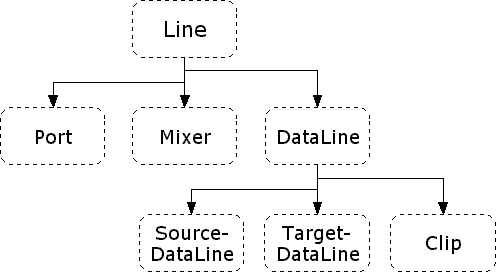1.1. Das Sampled Package
- Öffnen und von input and output devices wie das LineIn und LineOut der Soundcard
- Verwalten von (un-)buffered audio streams aus z.B. Audio Dateien
- Mixen von audio signalen
Datenformate
Das Datenformat wird repräsentiert als AudioFormat object, mit folgenden Eigenschaften
- Encoding technique, pulse oder modulation (PCM)
- Number of channels (1 für mono, 2 für stereo)
- Sample rate (number of samples per second, per channel)
- Number of bits per sample
- Frame rate
- Frame size in bytes (Summe der Größen aller Samples (für jeden Channel eins) zu einem Zeitpunkt)
- Byte order (big-endian or little-endian)
Dateiformate
Das Datenformat wird repräsentiert als AudioFileFormat object, mit den Eigenschaften:
- The file type (WAVE, AIFF, etc.)
- The file's length in bytes
- The length, in frames, of the audio data contained in the file
- An AudioFormat object that specifies the data format of the audio data contained in the file
Mixer
- Eine Device wird als mixer object dargestellt.
- Repräsentiert sowohl hardware (Soundcard) als auch software devices (Effect plugin).
- audio-input mixer: empfängt über input
ports (microphone input) und sendet durch TargetDataLines

- audio-output mixer: empfängt über Clips
oder SourceDataLines
und sendet durch output
ports (speaker).

- Verwaltet sogar mehrere audio input und output streams.
- Das Mixer interface unterstützt Synchronisation.
Line
Alle interfaces stammen von line ab. Die Line interface Hierachie:

Das Interface Line besitzt folgende Eigenschaften:
- Controls: gain, pan, reverb and sample rate.
- Open or closed status
- Events: Z.B. opens oder closes.
Das Interface DataLine besitzt folgende Eigenschaften, Methoden und Events:
- Audioformat
- Media position
- Buffer size
- Level
- Start and stop playback or capture
- Pause and resume playback or capture
- Flush
- Drain (block until all unprocessed data has been drained from the queue, and the data line's buffer has become empty)
- Active status
- Events START und STOP
Eine Besonderheit von Clip ist, das die audio Daten komplett geladen werden,so dass sie auch geloopt abgespielt werden können.
1.3. Zugriff Audio System Resourcen
AudioSystem
Durch die Klasse AudioSystem (es muß nicht erzeugt werden) können alle installierten Resourcen erfragt und angesprochen werden.
- Mixers
- Lines
- Format conversions
- Files and streams
Jede Klasse gibt mit z.B.
static Mixer.Info[] getMixerInfo();
Information Objects. Dieses Ojekt enthält Informationen wie z.B.:
- Name
- Version
- Vendor (Hersteller)
- Description
Durch das Informations Ojekt kann dann die gewünschte Device angesprochen werden:
TargetDataLine line;
// generate a info object
DataLine.Info info = new DataLine.Info(TargetDataLine.class, format);
// format is an AudioFormat object
// Obtain and open the line..
try {
line = (TargetDataLine) AudioSystem.getLine(info);
line.open(format);
} catch (LineUnavailableException ex) {
// Handle the error.
}
Alternativ kann man auch Konstanten verwenden:
try {
line = (Port) AudioSystem.getLine(Port.Info.MICROPHONE);
}
Rechte für Audio Resourcen
Die AudioPermission class regelt welche Rechte ein Applet/eine Application bezüglich des Audio Systems hat:
- Ein applet, das mit einem applet security manager läuft kann play, aber nicht record.
- An application running with no security manager can both play and record audio.
- An application running with the default security manager can play, but not record, audio.
1.4. Abspielen von Audio (Playing Back / rendering)
Es gibt zwei Arten Audio Daten abzuspielen:
- Clip: non-real-time (Audio Daten befinden sich preloaded im Speicher)
- SourceDataLine: streaming (real-time Daten bzw. zu viele Daten für den Speicher)
Clip
void open(AudioInputStream stream); void open(AudioFormat format, byte[] data, int offset, int bufferSize);
Mit den Methoden start und stop wird das Abspielen begonnen bzw. beendet.
Schreiben in eine SourceDataLine
void open(); void open(AudioFormat format); void open(AudioFormat format, int bufferSize);
//read chunks from a stream and write them to a source data line
line.start();
while (total < totalToRead && !stopped)}
numBytesRead = stream.read(myData, 0, numBytesToRead);
if (numBytesRead == -1) break;
total += numBytesRead;
line.write(myData, 0, numBytesRead);
}
...
//this is the final invocation of write
line.drain();
line.stop();
line.close();
line = null;
Monitoring eines Line Status
Mit folgender methode registriet man ein Objekt beim Line Objekt als Listener
public void addLineListener(LineListener listener);
, so daß LineEvents wie OPEN, CLOSE, START, and STOP empfangen werden können.
1.5. Aufnehmen von Audio (capturing / recording)
Lesen aus einer TargetDataLine
- read um Audio Daten vom Mixer zu erhalt.
- available methode
zum Prüfen, ob noch Daten im Puffer sind.
TargetDataLine line;
DataLine.Info info = new DataLine.Info(TargetDataLine.class,format);
// format is an AudioFormat object
// Obtain and open the line.
try {
line = (TargetDataLine) AudioSystem.getLine(info);
line.open(format);
} catch (LineUnavailableException ex) {
// Handle the error ...
}
ByteArrayOutputStream out = new ByteArrayOutputStream();
int numBytesRead;
byte[] data = new byte[line.getBufferSize() / 5];
// Begin audio capture.
line.start();
// Here, stopped is a global boolean set by another thread.
while (!stopped) {
// Read the next chunk of data from the TargetDataLine.
numBytesRead = line.read(data, 0, data.length);
// Save this chunk of data.
out.write(data, 0, numBytesRead);
}
1.6. Processing Audio with Controls
- Typische Controls sind gain, pan, and reverb
- Sie werden durch getControl
und eine Konstante angesprochen:
FloatControl volCtrl =
(FloatControl) lineIn.getControl(FloatControl.Type.VOLUME);
1.7. Verwendung von Dateien
Aus einer Datei lesen:
int totalFramesRead = 0;
File fileIn = new File(somePathName);
try {
AudioInputStream audioInputStream =
AudioSystem.getAudioInputStream(fileIn);
int bytesPerFrame = audioInputStream.getFormat().getFrameSize();
// Set an arbitrary buffer size of 1024 frames.
int numBytes = 1024 * bytesPerFrame;
byte[] audioBytes = new byte[numBytes];
try {
int numBytesRead = 0;
int numFramesRead = 0;
// Try to read numBytes bytes from the file.
while ((numBytesRead = audioInputStream.read(audioBytes)) != -1) {
// Calculate the number of frames actually read.
numFramesRead = numBytesRead / bytesPerFrame;
totalFramesRead += numFramesRead;
// Here, do something useful with the audio data that's
// now in the audioBytes array...
}
} catch (Exception ex) {
// Handle the error... (UnsupportedAudioFileException)
}
} catch (Exception e) {
// Handle the error...
}
In eine Datei schreiben:
File fileOut = new File(someNewPathName);
AudioFileFormat.Type fileType = fileFormat.getType();
if (AudioSystem.isFileTypeSupported(fileType, audioInputStream)) {
AudioSystem.write(audioInputStream, fileType, fileOut);
}